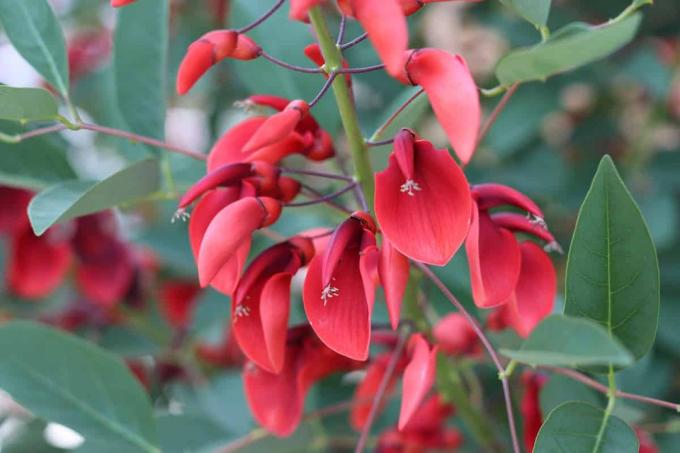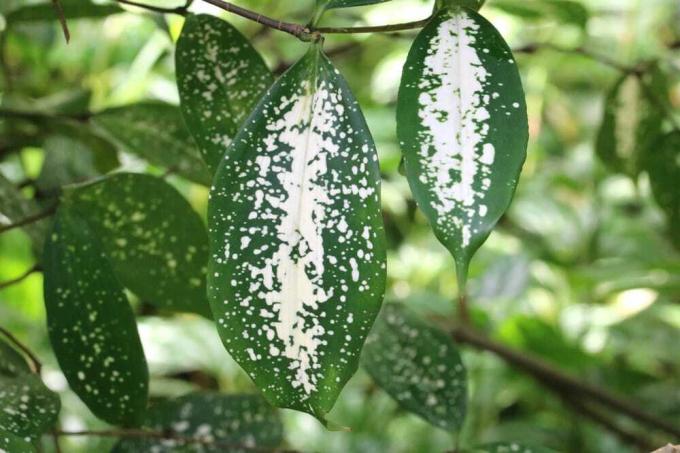

Table of contents
- Characteristics of the coral shrub
- Location and wintering of the coral shrub
- Water and fertilize the coral bush
- Cut Erythrina crista-galli
- Repot coral shrub
- soil / substrate
- Cultivation / propagation
- diseases and pests
They were probably introduced to Europe by the Spaniards. In the temperate zones of Central Europe, the coral shrub is cultivated as a container plant because it is not hardy.
Characteristics of the coral shrub
The coral shrub forms a tree-like trunk that becomes gnarled over the years, creating deep furrows in the bark. Its appearance is reminiscent of a vine. Every year it drives strong, long shoots with green foliage. At the ends, clusters of up to 40 cm long form with bright red butterfly flowers, to which the plant owes its name.
- Erythrina crista-galli translates into German as "Red Cockscomb".
- The conspicuous exotic can grow up to 1.50 m in a bucket...
- ... and flowers from June to September. It forms strong spikes on its branches.
Location and wintering of the coral shrub
- The coral shrub likes it very sunny. However, the heat should not build up.
- A sunny spot with a light breeze is ideal.
- The container plant can be placed on the terrace from May as soon as there is no longer any frost to be expected.
The coral shrub tolerates light frost down to -5 °C. At the end of September or even later, he should still move to a cool and dark place in the house. It can stand in a conservatory all year round. After the flowering period, the shrub gradually loses its leaves and the shoots die off. This is a completely natural process that cannot and should not be stopped by additional watering. This means that it does not need any light in winter and can be kept in the basement. However, it must not dry out completely. The soil should be kept slightly moist. Before the shrub comes back onto the terrace, it should be placed in a bright spot in the apartment from March or April to encourage it to propel itself forward. When it comes outside, it can first stand in the shade for a few days to get used to it, to avoid burning the leaves.

Water and fertilize the coral bush
As soon as the growth phase begins, the coral shrub needs water regularly, in a moderate amount at the beginning, but all the more as it grows. On hot summer days it may also be necessary to provide him with water in the morning and in the evening.
- From September, the amount of water can be gradually reduced.
- In the winter quarters you should water very little, but make sure that the soil does not dry out completely.
- From the middle of April you should add a portion of liquid complete fertilizer to the irrigation water every 7-10 days.
- Alternatively, the need for nutrients can also be covered with long-term fertilizer.
- The first dose is given at the beginning of April and should be refreshed again at the beginning of July.
Cut Erythrina crista-galli
In the fall, Erythrina crista-galli shoots begin to die and dry up. You should just let that happen. As soon as new shoots start to grow from the dormant eyes on the trunk and at the branches of the trunk in spring, you should cut back any old shoots that are still there. The flowers appear on the new shoots. The shrub can be pruned up to the end of May to give the crown a certain shape. After that you should let it grow. If you regularly remove wilted inflorescences in between, the shrub will be encouraged to form more new inflorescences.
Repot coral shrub
The coral shrub should be repotted every two to four years. The best time to do this is early May when the shrub is moving outside. When repotting, it is good for the plant if you shorten the marginal roots a little. This encourages the roots to branch out more, allowing them to grow better in the new soil. You should only use pots or tubs that have a hole in the bottom so that excess water can drain off easily.
soil / substrate
- High-quality potting soil, which stores water and nutrients well, is suitable for planting the Erythrina crista-galli.
- It should contain coarse-grained parts (gravel, lava dust, perlite, etc.), which ensure that the soil remains loose and no waterlogging occurs.
- Caution: The proportion of peat should not be too large.
Cultivation / propagation
Erythrina crista-galli can be grown from seed or propagated from cuttings. Indoors, it can be grown from seed all year round. To do this, let the large seeds, reminiscent of beans, soak in lukewarm water overnight and place them 1 cm deep in potting soil the next day. At a temperature of 20 - 25 °C, it takes 2 - 4 weeks for the seedlings to sprout. After 5 - 8 weeks the small plants can be pricked out. Incidentally, the seeds are poisonous, so should not get into the hands of small children. When growing from seed, it takes about four years for the plant to flower for the first time. When propagating from cuttings, the first flowers appear earlier. The best time for this is in April, shortly after the bush has just sprouted. A strong shoot with three leaves is cut off a few centimeters below the node and placed in a small pot with loose, moist soil for rooting. The pot needs a bright and evenly warm location. High humidity promotes the growth process.
diseases and pests
Since the coral bush sheds most of its shoots every year, pests can hardly settle in for a long time. When it is extremely hot in summer, it is often attacked by spider mites. Aphids can also occur from time to time. If you notice the infestation early on, it is usually sufficient to spray the whole plant several times with water from the garden hose. If the pest infestation has been registered late, it may also be necessary to treat the shrub with a plant protection spray.
 garden editorial
garden editorial I write about everything that interests me in my garden.
Learn more about indoor plant dictionary

Ornamental asparagus, Asparagus densiflorus: Care from A - Z
Ornamental asparagus is a popular decoration for the garden or balcony. The following guide with tips for care from A to Z shows how Asparagus densiflorus and other species of the plant such as Asparagus plumosus or Asparagus sprengeri can be cultivated.

Easy-care office plants - 18 plants for the office
If you have the opportunity to make your office a little more personal, you often use office plants because they have several good properties. You can find out which indoor plants are suitable here.

20 plants for children's rooms: non-toxic and easy to care for
Decorative plants are part of the design of the children's room. Plants in their own room give the offspring a comprehensive insight into the care of the plants, even if they are easy to care for. It is important when choosing plants that you choose non-toxic species.

Pruning & branching Money Tree, Crassula ovata
The money tree proves to be well tolerated by pruning. With targeted cuts, it can be raised to become a standard tree or formed into a bonsai. There are no limits for your creativity. The plant tolerates rejuvenation cuts as well as educational cuts or the radical removal of all shoots.

Dragon Tree, Dracaena surculosa: Care A – Z
Dracaena surculosa is a species of dragon tree popular for its fresh green and brightly mottled leaves. In contrast to the typical dragon tree, this one is more reminiscent of a bamboo because of its thin, branched stalks. But that is exactly what makes it so decorative.

10 useful indoor plants for a healthy indoor climate
Indoor plants transform a room into an oasis of well-being. They are decorative and healthy at the same time. They help to improve the room climate by reducing the concentration of carbon dioxide, optimizing the air humidity and binding pollutants from furniture and carpets. Which houseplants are recommended?
